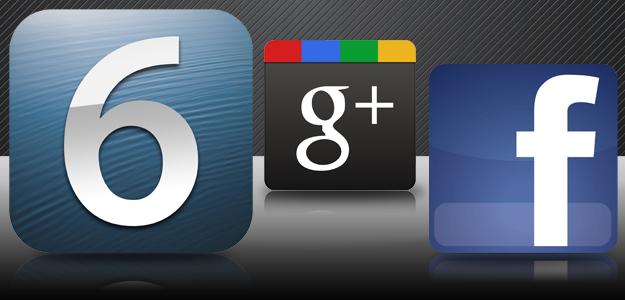 In case you were hiding under a rock, Apple recently came under some heavy criticism for replacing Google’s Map app with its own competing client, effectively wiping all things native and Google away with the iOS 6 upgrade. While Apple removed native Google products, it did just the opposite for Facebook and also integrated the social media behemoth into iTunes as well as natively into iOS 6. But despite the seemingly different approaches Apple is taking in regards these two platforms, the iOS 6 upgrade could actually pose a threat to both.
In case you were hiding under a rock, Apple recently came under some heavy criticism for replacing Google’s Map app with its own competing client, effectively wiping all things native and Google away with the iOS 6 upgrade. While Apple removed native Google products, it did just the opposite for Facebook and also integrated the social media behemoth into iTunes as well as natively into iOS 6. But despite the seemingly different approaches Apple is taking in regards these two platforms, the iOS 6 upgrade could actually pose a threat to both.
Apple’s brand remains strong
The backlash from the Maps fiasco has been palpable—users have been complaining about inaccurate addresses, missing landmarks, and a lack of public transportation information on Apple’s version of Maps. But while the premature release of Maps likely tarnished a brand synonymous with perfection, it’s also showed us how badly Apple can mess up and still see high adoption rates. It’s those numbers that, despite any user outrage, should make Google Maps — and for that matter, Facebook and its photos application (we’ll get to that shortly) — a little nervous. Apple has released so-so competitor products, and even though they might not be better and they might not be gaining a lot of early love, the iOS reputation might be enough for the brand to coast on.
Google Maps has more ground to lose

Google is reportedly planning on releasing its new iOS Maps app—despite Executive Chairman Eric Schmidt’s earlier announcement that the company hadn’t made any moves to do so. When asked about whether or not Google had immediate plans for an updated iOS 6 version, Nate Tyler, a representative at Google, says, “We believe Google Maps are the most comprehensive, accurate and easy-to-use maps in the world. Our goal is to make Google Maps available to everyone who wants to use it, regardless of device, browser, or operating system.” Tyler didn’t expand on a timeline for the new App, but a recent article in The New York Times reported that Google has plans to have its iOS 6 Maps app finished by the end of the year — and it would be wise to do so, as quickly as possible, before consumers either become comfortable with a third-party alternative or succumb to the Apple replacement.
A Facebook photo challenger?
Much attention has been given to the iTunes integration with Facebook — which lets users see if any of their friends Like apps, music, or books they’re considering buying — as well as iOS 6’s native integration with Facebook. But the social media site is also seeing some quiet competition from Apple’s new photo-sharing and commenting feature, Photo Stream.
It hasn’t received much attention yet, but this new mechanism allows users to easily create and share multiple albums through the cloud so that photos instantly appear in a user’s photo stream without having to manually send them. Users can share photos and simultaneously add and edit albums with select individuals or groups without having to deal with privacy issues that worry many Facebook users.

At this stage, and with Photo Stream still somewhat under the radar, it doesn’t yet pose a real threat to the photo-sharing tools Facebook offers. Commenting on whether or not Apple’s Photo Stream could be a competitor to Facebook, Ian Broyles, developer of Versagram, says, “[It’s] not a threat to Facebook in its current form. People know how to share a photo on Facebook easily but I would guess most iOS 6 users don’t know iOS 6 even has shared Photo Stream. Also, the requirement to have an iCloud account is a big barrier to sharing photos that ‘Grandma’ can easily view.”
But it often takes time for new native apps to capture mass attention—and with 100 million iOS 6 users already, and more than 150 million iCloud users—Photo Stream has a pretty solid number of potential consumers. For now at least, Apple users have an interesting—and more personal—alternative to group photo-sharing and commenting.
Slow and steady might just win the race… again
Half-finished and unpromoted products are anything but synonymous with Apple’s brand — many even questioned whether Apple would have prematurely put out its own mapping app if Steve Jobs had still been CEO. It’s clear from Apple CEO Tim Cook’s public apology regarding the Maps fiasco and its hush-hush treatment with iCloud and Photo Streams that iOS 6 may not have been totally ready for its users.
Regardless, it’s here — and also regardless, we’re using it: 60 percent of iPhones are running iOS 6 now. With all the new iPhone 5s consumers are pocketing — five million iPhone 5s were sold within the first three days of its release — that number is only going to go up. Like always, Apple can do no wrong; or rather, it can do a lot of wrong, and we’re going to put up with it and adopt what it throws our way, and that’s something that should serve as a bit of a warning for Google Maps and Facebook Photos. Apple’s new products might not be shining now and they certainly aren’t beloved, but they will undoubtedly get used — and those are that numbers that matter in the end.


